November 2, 2009 feature
Second Law of Thermodynamics May Explain Economic Evolution

(PhysOrg.com) -- Terms such as the "invisible hand," laissez-faire policy, and free-market principles suggest that economic growth and decline in capitalist societies seem to be somehow self-regulated. Now, scientists Arto Annila of the University of Helsinki and Stanley Salthe of Binghampton University in New York show that economic activity can be regarded as an evolutionary process governed by the second law of thermodynamics. Their perspective may provide insight into some fundamental economic questions, such as the causes of economic growth and diversification, as well as why it’s so difficult to predict economic growth and decline.
As Annila and Salthe explain in their study published in Entropy, the second law of thermodynamics was originally formulated to describe the flow of heat from hot to cold areas. However, when formulated as an equation of motion, the second law can be used to describe many other processes in energetic terms, such as natural selection for the fittest species, organization of cellular metabolism, or an ecosystem’s food web. In these systems, free energy is consumed; that is, energy is dispersed in a way to promote the maximal increase of entropy, which is the essence of the second law.
While economic activities are traditionally viewed as being motivated by profit, Annila and Salthe argue that the ultimate motivation of economic activities is not to maximize profit or productivity, but rather to disperse energy. From this perspective, a growing economy consists of entities (e.g. products, labor, etc.) that are assigned an energy density resulting from their individual production processes. These density differences are the forces that direct energy flows (e.g. manufacturing processes) to equalize energy density differences within the system and with respect to its surroundings.
The scientists argue that this tendency to disperse the maximum amount of energy (that is, to consume free energy in the least time) is what gives rise to economic laws and regularities. Further, economies organize themselves in hierarchical systems within systems to improve on energy dispersal and to access new sources of energy. For instance, the global economy is comprised of national economies, each housing economic zones that in turn accommodate districts, firms, households and so on, organized so that global resources are produced and consumed most effectively in terms of energy dispersal.
From this thermodynamic perspective, decision making is ultimately about choosing the action that causes energy to flow along the most steeply descending energy gradient. For example, when faced with two identical products where one is cheaper than the other, a consumer will likely choose the cheaper product.
“When investing on the cheaper but equally good product, more energy (in one’s assets) is left to be dispersed by buying other goods,” Annila explained to PhysOrg.com. “Also, when the cheaper product sells better, the energy used in its production gets consumed faster.”
However, decision-making is not always this straightforward because consumers, producers, and other players in the market make decisions based on their subjective views of energy gradients, which are affected by diverse and often conflicting factors. Each player in the market may prefer a particular series of actions (their strategy) to move from one state to another that is higher in entropy production. When the circumstances change, for example due to other players’ actions, a player may revise their strategy in the quest to optimally consume free energy.
As the scientists explain, it’s inherently impossible to predict future economic growth and decline in any detail from this perspective. The fundamental reason for this unpredictability is that the economy’s energy density is not constant, so that a player’s decision will affect future decisions that are open for other players. Physically speaking, the forces (free energy in resources) that drive the flows (economic activities) are in turn affected by the flows and so on. Moreover, each player tries to take into account how their decision will affect the decisions made by others. The result of these complex interactions based on subjective decision-making means that economies with highly effective mechanisms of energy dispersal, such as the stock exchange and the market of raw materials, may change very rapidly and unexpectedly.
“The second law encourages activities that consume free energy as soon as possible,” Annila said. “Therefore, there is the quest to increase productivity and throughput and to find new sources of energy. Moreover, the second law reveals that it is impossible to predict in detail the optimal course of energy utilization because the chosen course itself affects the choice for future actions. Therefore, it makes sense to favor statistically independent actions that open new opportunities to consume free energy, and likewise to regard the use of insider information as illegal since it narrows the choices.”
More information: Arto Annila and Stanley Salthe. “Economies Evolve by Energy Dispersal.” Entropy, 2009, 11, 606-633; doi:10.3390/e11040606
Copyright 2009 PhysOrg.com.
All rights reserved. This material may not be published, broadcast, rewritten or redistributed in whole or part without the express written permission of PhysOrg.com.
















